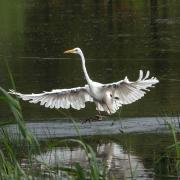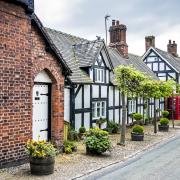Together, the Wildlife Trusts care for 2,300 diverse and beautiful nature reserves. These include ancient woodlands, lakes, meadows, rivers urban parks, hills, heather-clad heathlands, marshes and coastlines. UK nature is in decline, but these are some of the last refuges where wild plants and animals are given the space they need to survive.
The 30 nature reserves cared for by Cheshire Wildlife Trust are some of the best wildlife havens remaining across our region. They are homes for water voles, breeding grounds for lapwings and overwintering shelter for bitterns. Here are just some of the nature reserves in our care, the people behind them, and the wildlife that lives there.
Gowy Meadows – a refuge for water voles.
Gowy Meadows Nature Reserve, near Ellesmere Port, is our largest nature reserve. This 410-acre reserve provides an extensive network of wildlife-rich ditches, hedgerows, wet grassland, ponds and scrapes where more than 150 bird species have been recorded. The River Gowy running through the reserve, is home to aquatic invertebrates, dragonflies, otters and water voles.
Water voles are one of the UK’s fastest-declining mammals. Up to 90 per cent of the population has disappeared since the 1970s due to habitat loss and fragmentation. Water voles are a vital part of river ecosystems. Their burrowing, feeding and movements help create conditions for other animals and plants to thrive.
Senior living landscape officer Jack Helsby, who leads the work at Gowy Meadows, says: 'We carry out a wide variety of work to support water vole populations. For example, creating ponds near the existing ditch network will establish a variety of aquatic vegetation. This provides excellent food and shelter for water voles. We’ll also be restoring a network of old river channels, connecting them to other watercourses to allow water voles to move more freely. We have cameras set up to monitor their presence, so hopefully we’ll capture some exciting footage.'


Danes Moss – a refuge for common lizards
Danes Moss Nature Reserve, near Macclesfield, is the largest and highest lowland-raised peat bog in Cheshire. Peat bogs are one of the scarcest and most threatened habitats in the UK.
The reserve is home to a whole host of dragonflies, damselflies, butterflies and common lizards. Reptiles, such as common lizards, are suffering global declines and are threatened with extinction.
Reptiles can be particularly vulnerable because they tend to live in small, isolated areas and need places to shelter and hibernate. However, they also need open areas to bask in the warm sunshine. Their habitat is being divided by built-up areas and farmland, making it difficult for populations to spread out.
Living landscape officer Jamie White manages the work at Danes Moss. He says: 'The priority at Danes Moss is to maintain the bog habitat. We do this by removing birch scrub from the moss to retain moisture. We then move the cut birch stems into the woodland to provide deadwood habitat piles. Each year we thin some of woodland on the reserve, allowing more sunlight to penetrate through the canopy, which in turn encourages species such as oak and rowan to become better established in the woodland.
'Common lizards bask on the exposed surfaces like the boardwalk, as well as on the edge of the woodland. They benefit from the work we do to maintain the bog. Brash piles provide space to hibernate. Maintaining open areas on the moss provides space for basking in the sunshine. Encouraging water retention provides habitat for invertebrates such as spiders, flies and beetles, which common lizards feed on.'

Swettenham Valley – a refuge for butterflies
Swettenham Valley Nature Reserve, near Holmes Chapel, is one of Cheshire’s hidden gems. A mosaic of habitats including ancient woodland, a network of ponds and species-rich meadows. Together, these habitats support an abundance of wildlife, most notably valuable populations of 18 resident species of butterfly, such as brimstones, ringlets and small skippers.
Insects, including butterflies, pollinate around 85 per cent of our crops and are an indicator of a healthy environment. They’re also important parts of the food chain, providing food for birds, bats and small mammals. However, half of British butterflies are now classed as either threatened or near threatened with extinction. This is due to habitat loss, as well as the climate crisis causing extreme weather events.
Senior living landscape officer Ralph Connolly who leads the Wildlife Trust programme work at Swettenham, says: 'With a mix of woodland and grassland, Swettenham provides an excellent habitat for many species of butterfly. We will be working to create more open grassland habitat, providing food and shelter for butterflies and other pollinators. By creating small clearings along the edge of the woodland areas, we’ll also be able to create a sunny microclimate which is perfect for sun-loving butterflies and encourages a great diversity of flora.'

Marbury Reedbed – a refuge for bitterns
Marbury Reedbed, near Northwich, is a reedbed and woodland sitting within Marbury Country Park, on the western edge of Budworth Mere. The open water contains a rich selection of plants including water lilies and provides valuable feeding and breeding habitat for kingfishers and grebes. The reedbed is also used as an overwintering site for bittern.
Bitterns are one of the rarest breeding birds in the UK. A shy breed of heron, they spend almost all their time hidden away in reedbeds. They’re more likely to be heard than seen, thanks to the male’s ‘booming’ mating call. They are threatened by wetland drainage and habitat loss and were once on the brink of extinction in the UK. In 1997 there were just 11 males left. However, the good news is that populations are increasing, thanks to the protection of key breeding sites such as Marbury Reedbed.
Living landscape officer Graham Borden-Long, who manages Marbury Reedbed, says: 'We close public access between October and March to protect overwintering bitterns from disturbance. During this time, we can clear the inflow to the reedbed to ensure it’s a healthy, safe habitat. Bitterns favour open reedbed, so we remove some encroaching willow which, if left, would slowly develop into wet woodland.'


Bickley Hall Farm – a refuge for lapwings
Surrounded by beautiful Cheshire countryside, Bickley Hall Farm sits just outside the village of Malpas and is managed as an organic, nature-friendly farm in partnership with a local grazier. The 210-acre reserve has species-rich meadows, wet grassland, pastures and diverse hedgerows. These habitats are great for invertebrates, small mammals and in particular, hundreds of feeding farmland birds such as lapwing in autumn and winter.
Lapwings have suffered a serious decline as a breeding species across the UK with changes in farming methods leading to habitat loss. Drainage of wetlands and a reduction in uncultivated grassland have also contributed to these declines. Although some birds will head to continental breeding grounds in the spring, for those that stay in the UK, the ponds, wetlands and hay meadows at Bickley Hall Farm provide an excellent breeding habitat.
Land management officer Darren Banks, who manages Bickley Hall Farm, says: 'I love working at Bickley Hall Farm. This year I’ll be doing some hedge laying, creating more wader scrapes and working with a local grazier to ensure we get the wet grassland in the right condition for both overwintering and breeding wading birds Waders such as lapwings prefer to nest on bare ground or in short grass so they can see predators more easily, so making sure is the grass is grazed to just the right height coming into early spring is really important. The new ponds and wider scrapes will also help lapwings to feed themselves and their young.'

Cheshire Wildlife Trust, has launched an appeal to help complete vital work at its nature reserves.
Ben Gregory, director of nature recovery at Cheshire Wildlife Trust says: 'It costs £404,068 each year to manage our nature reserves for wonderful wildlife. We work hard to be as effective as possible and to apply for all available funding for land management. However, there's a £52,298 shortfall this year. It’s vital to nature’s recovery that we protect these havens for wildlife and provide space, food and shelter for species that are under threat.'
A donation of £44 could help us to protect an acre of habitat for a whole year. Can you help us protect Cheshire’s last refuges for wildlife? Or perhaps your business or workplace would be interested in supporting a whole nature reserve for a year? To donate or find out more visit cheshirewildlifetrust/cheshireslastrefuges



























